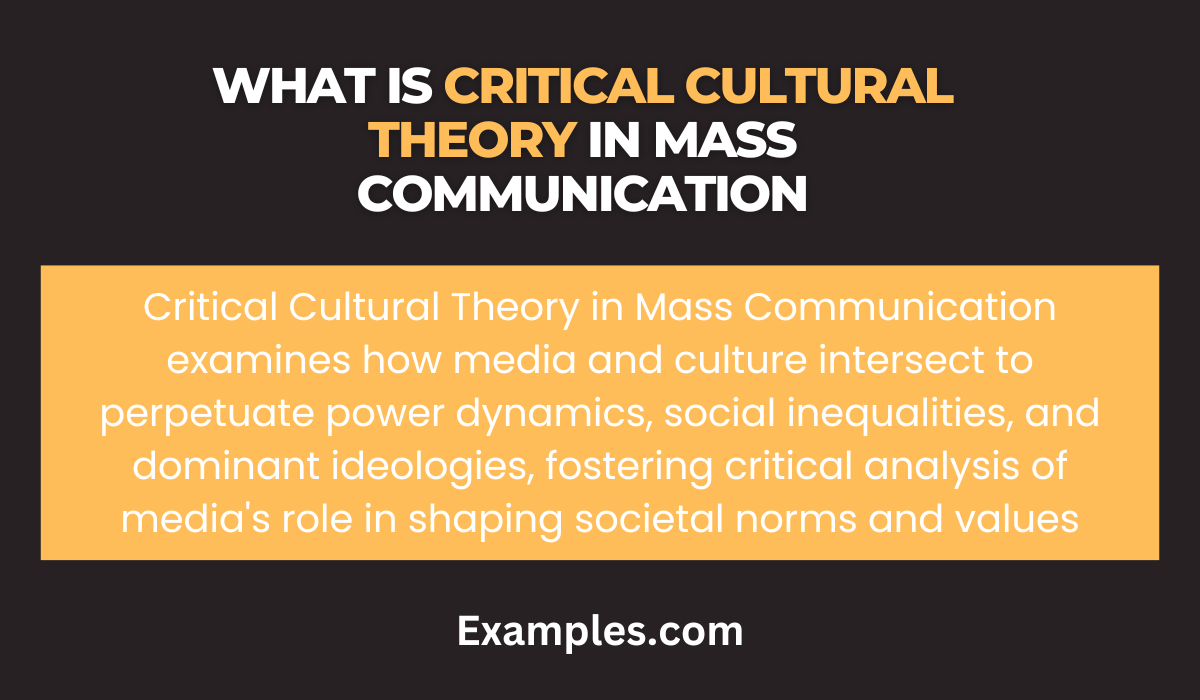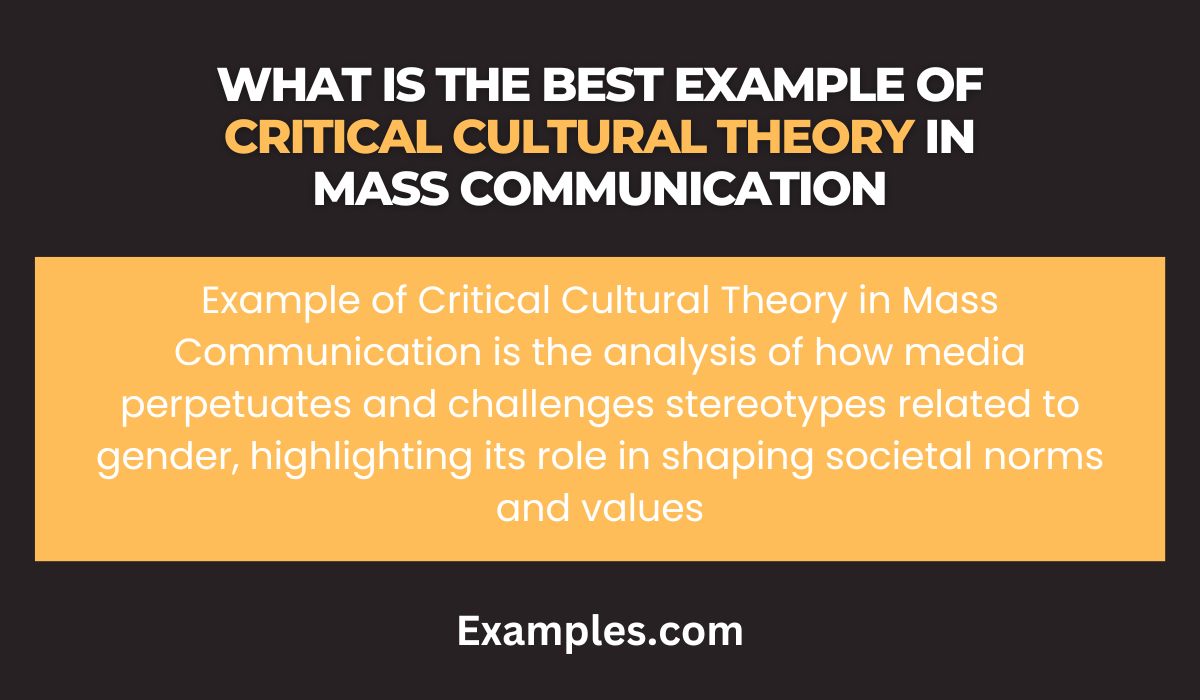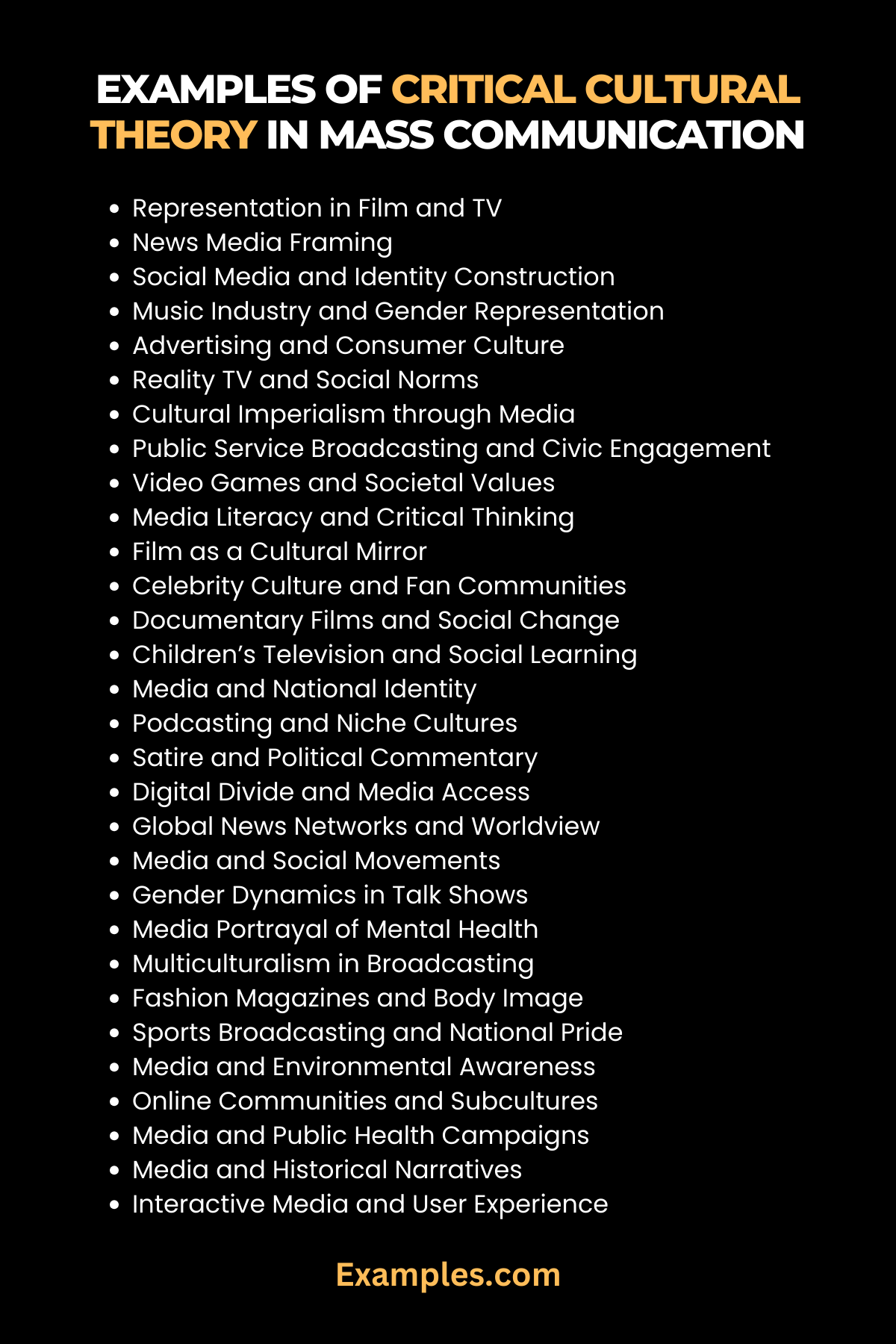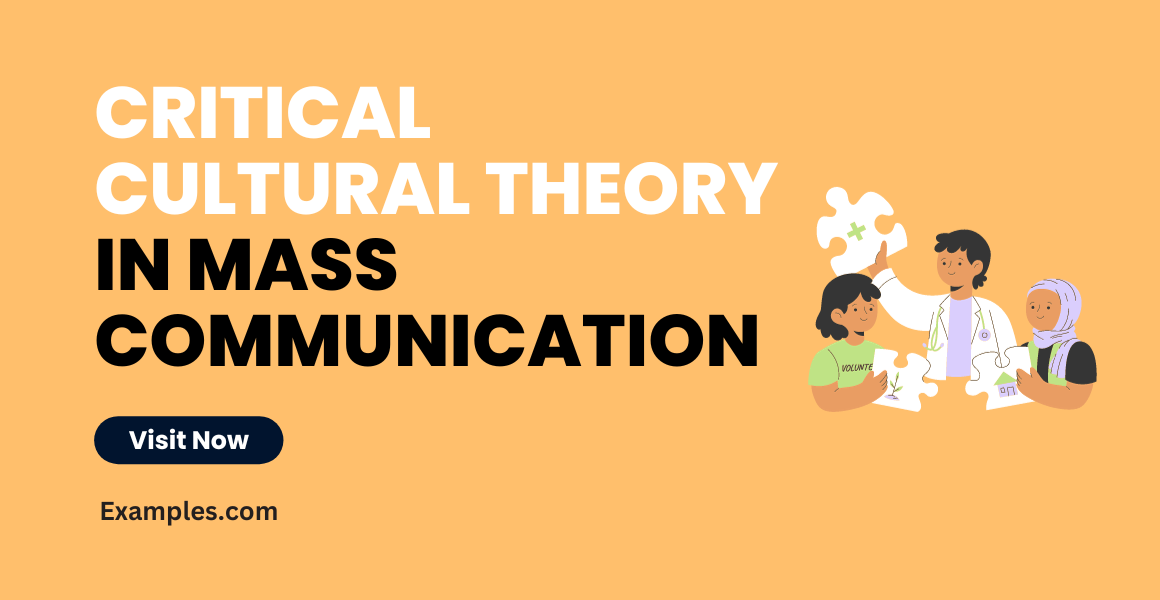29+ Critical Cultural Theory in Mass Communication Examples
Exploring Critical Cultural Theory in Mass Communication offers a profound understanding of how media shapes societal beliefs and values. This complete guide delves into the intricate relationship between media and culture, highlighting essential aspects like Mass Communication Characteristics and Types of Mass Communication. As we unravel the layers of critical cultural theory, we discover its impact on various fields, including journalism, social media, and broadcasting. This exploration is not just academic; it’s a journey into the heart of how mass communication molds our worldviews and influences our daily lives.
What is Critical Cultural Theory in Mass Communication
Critical Cultural Theory in Mass Communication is an analytical framework used for examining the complexities of culture within the sphere of mass communication. This theory explores how mass media and communication technologies shape and reflect cultural values, power dynamics, and social structures. It delves into how media representations influence societal norms, ideologies, and the collective consciousness.

History of Critical Cultural Theory in Mass Communication
The roots of Critical Cultural Theory in Mass Communication can be traced back to the mid-20th century. It emerged as a response to traditional mass communication theories that often overlooked the intricate relationship between culture and media. Pioneers like Stuart Hall and Raymond Williams significantly contributed to this field, emphasizing how media is not merely a tool for information dissemination but a powerful entity that can shape and reinforce cultural norms and values. Over the years, the theory has evolved, incorporating contemporary issues like digital media influence and the role of social media in shaping public opinion.
What is the Best Example of Critical Cultural Theory in Mass Communication
One of the best examples of Critical Cultural Theory in Mass Communication is the analysis of news media portrayal of social issues. For instance, the representation of minority groups in news broadcasts can significantly influence public perception and attitudes. If a news channel repeatedly portrays a particular ethnic group in a negative light, it may perpetuate stereotypes and reinforce cultural biases. This example highlights how media content is not just a reflection of reality, but also a constructor of societal norms and opinions.
Another significant example is the portrayal of gender roles in advertising. Advertisements often use specific narratives and imagery to convey societal expectations about gender, thus influencing public perception and behavior. For instance, an analysis of toy commercials can reveal how they often reinforce traditional gender roles, thereby shaping children’s understanding of masculinity and femininity from a young age.
Through these examples, Critical Cultural Theory underlines the influential role of media in mass communication scenarios and its profound impact on societal beliefs and behaviors.

30 Examples of Critical Cultural Theory in Mass Communication
Critical Cultural Theory in mass communication examines how media shapes and reflects cultural norms, values, and power dynamics. It’s essential for understanding the societal impact of media messages and their role in cultural evolution. This approach is pivotal in dissecting the complex layers of Mass Communication in Real Life and the Main Functions of Mass Communication.

- Representation in Film and TV: Analyzing how different ethnic groups are portrayed in media, observing stereotypes, and their effect on public perception
Example: A study of Hollywood movies showing the evolution of Asian character representation, from stereotypical roles to more nuanced, leading characters. This shift reflects broader societal changes and challenges historical stereotypes. - News Media Framing: Examining how news outlets frame political events or social issues, influencing public opinion
Example: An analysis of how different news channels report on climate change – some may frame it as a political debate rather than a scientific consensus, affecting public perception and policy. - Social Media and Identity Construction: Investigating how individuals use platforms like Instagram to construct and project their identities
Example: Exploring the trend of ‘influencers’ who create idealized online personas, shaping viewers’ perceptions of beauty and lifestyle standards. - Music Industry and Gender Representation: Assessing the portrayal of gender roles in music videos and lyrics
Example: A study on the portrayal of women in hip-hop music videos, examining how these representations influence societal views on gender. - Advertising and Consumer Culture: Understanding how advertisements reinforce certain cultural values and consumer behaviors
Example: Analysis of Super Bowl commercials and their reflection of American culture, values, and consumerism. - Reality TV and Social Norms: Looking at how reality shows represent and sometimes distort social realities
Example: An examination of shows like “The Bachelor” and their impact on viewers’ perceptions of romance and relationships. - Cultural Imperialism through Media: Exploring how Western media dominance can impact and sometimes overpower local cultures
Example: The influence of American movies and TV shows on global fashion trends, lifestyle, and cultural values. - Public Service Broadcasting and Civic Engagement: Studying how public broadcasting services contribute to democratic discourse
Example: The role of PBS in providing educational content and fostering community engagement in the U.S. - Video Games and Societal Values: Analyzing the narratives and values embedded in video games
Example: Exploring how games like “The Sims” reflect and shape players’ understanding of everyday life and social interactions. - Media Literacy and Critical Thinking: Promoting the ability to critically analyze media messages and their impact
Example: Educational programs teaching students to deconstruct advertisements and understand their persuasive techniques. - Film as a Cultural Mirror: Understanding how cinema reflects and influences societal issues and trends
Example: Analysis of Oscar-winning films over decades, revealing changing societal concerns and values. - Celebrity Culture and Fan Communities: Investigating the impact of celebrity culture on fan identity and behavior
Example: The role of social media in shaping fan communities and their interactions with celebrities. - Documentary Films and Social Change: How documentaries bring attention to social issues and inspire action.
Example: Documentaries like “An Inconvenient Truth” raising awareness about climate change and influencing public policy. - Children’s Television and Social Learning: Examining how children’s shows can teach values and social skills
Example: The educational impact of shows like “Sesame Street” on early childhood development. - Media and National Identity: Analyzing how media shapes and reflects a nation’s identity and values.
Example: The portrayal of American values in Hollywood films and its influence on international perceptions of the U.S. - Podcasting and Niche Cultures: Exploring the rise of podcasts and their role in catering to specific interests and communities.
Example: The growth of true crime podcasts and their impact on public interest in criminal justice issues. - Satire and Political Commentary: How satire in media serves as a tool for political commentary and critique.
Example: Shows like “Saturday Night Live” using humor to comment on political events and figures. - Digital Divide and Media Access: Studying the impact of unequal access to digital media on different communities.
Example: The disparity in internet access between urban and rural areas and its impact on information consumption. - Global News Networks and Worldview: Investigating how international news networks shape global perspectives.
Example: The influence of networks like BBC and Al Jazeera on international understanding of global events. - Media and Social Movements: The role of media in facilitating or hindering social movements.
Example: The use of social media in the Arab Spring and its role in mobilizing protests. - Gender Dynamics in Talk Shows: Exploring how gender roles are played out and challenged in talk show formats.
Example: The impact of talk show hosts like Oprah Winfrey in discussing and shaping gender-related issues. - Media Portrayal of Mental Health: Examining how mental health is represented in various media forms.
Example: The depiction of mental health issues in TV series and its impact on public understanding and stigma. - Multiculturalism in Broadcasting: How broadcasting reflects and caters to a multicultural society.
Example: The representation of diverse cultures in public broadcasting networks. - Fashion Magazines and Body Image: The impact of fashion media on body image perceptions and standards.
Example: Analysis of the evolution of body image standards in magazines like Vogue. - Sports Broadcasting and National Pride: Understanding how sports media fosters a sense of national identity and pride.
Example: The coverage of the Olympics and its role in uniting countries under a common national identity. - Media and Environmental Awareness: How media contributes to the discourse on environmental issues.
Example: The role of nature documentaries in raising awareness about environmental conservation. - Online Communities and Subcultures: The formation and influence of online communities and their cultures.
Example: The rise of fandom communities on platforms like Tumblr and their cultural impact. - Media and Public Health Campaigns: The role of media in disseminating public health information.
Example: The use of television and social media in public health campaigns, like anti-smoking ads. - Media and Historical Narratives: How media shapes and perpetuates historical narratives.
Example: The portrayal of historical events in movies and its influence on public understanding of history. - Interactive Media and User Experience: Exploring how interactive media like VR changes user engagement and perception.
Example: The use of VR in storytelling and its potential to create immersive, empathetic experiences.
Role of Critical Cultural Theory in Mass Communication
Critical Cultural Theory plays a pivotal role in mass communication, serving as a lens through which media content and its societal impacts can be analyzed and understood. Here are some key points highlighting this role:
- Analyzing Power Dynamics: It helps in dissecting the power relations within mass media content, revealing how media can perpetuate or challenge social norms and power structures.
- Understanding Audience Interpretation: This theory aids in understanding how diverse audiences may interpret media messages differently based on their cultural backgrounds.
- Media Content Critique: It provides tools for critiquing media content, assessing how cultural contexts and societal issues are represented or misrepresented.
- Highlighting Marginalized Voices: Critical Cultural Theory emphasizes the importance of giving voice to marginalized or underrepresented groups in mass media.
- Assessing Cultural Impact: It allows for an examination of how mass communication influences and shapes cultural norms, values, and identities.
Importance of Critical Cultural Theory in Mass Communication
The importance of Critical Cultural Theory in mass communication cannot be overstated, as it offers crucial insights into the role of media in society. Here are several points detailing its significance:
- Promotes Cultural Sensitivity: It encourages sensitivity towards different cultures and perspectives in mass communication scenarios/situations.
- Fosters Critical Thinking: This theory cultivates critical thinking among audiences, enabling them to question and analyze media content more deeply.
- Guides Ethical Media Practices: Critical Cultural Theory informs ethical considerations in media production, highlighting the need for responsible and fair representation.
- Enhances Media Literacy: It enhances media literacy, equipping audiences with the skills to discern and understand the cultural implications of media messages.
- Drives Social Change: By critiquing existing media practices and advocating for inclusivity, it can drive positive social change.
How to Use Critical Cultural Theory in Mass Communication
Implementing Critical Cultural Theory in mass communication involves a mindful approach to creating and analyzing media content. Here’s how it can be effectively utilized:
- Content Creation: When creating media content, incorporate diverse cultural perspectives to ensure a broad and inclusive representation.
- Media Analysis: Use the theory to analyze existing media, assessing how different cultural groups are portrayed and what messages are conveyed.
- Educational Tool: In mass communication education, this theory can be taught as a fundamental concept to help future media professionals understand the cultural implications of their work.
- Policy Formulation: It can guide policy-making in media to ensure culturally sensitive and ethical practices.
- Audience Engagement: Engage with audiences from various cultural backgrounds to understand their perspectives and experiences with mass media.
In examining Critical Cultural Theory in Mass Communication, it’s evident that this approach is crucial for understanding the nuanced interplay between media and culture. It highlights how mass media both shapes and reflects cultural values, impacting society’s beliefs and behaviors. The theory underscores the importance of scrutinizing media messages and their societal implications, emphasizing the need for responsible media production and consumption to foster a more informed and critical public.



